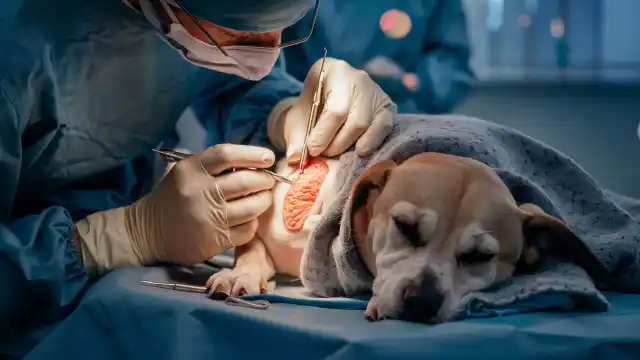Dog Gland Removal Pros And Cons: Anal glands are small sacs near your dog’s anus that help mark territory & communicate with other animals through a smelly fluid.
This blog will cover the pros & cons of gland removal, signs of issues & tips for post-surgery care & prevention.
What Are Dog Anal Glands?
Anal glands (also called anal sacs) are small glands near a dog’s anus.
They hold a smelly fluid that helps dogs mark their territory & communicate with other animals.
Sometimes, these glands can become blocked, infected, or swollen, which can cause discomfort & health problems.
If this happens, a vet might need to squeeze the glands manually or give medication to fix the issue.
Dog Gland Removal Pros And Cons
In the below table, I’ve mentioned anal gland removal dogs pros and cons.
| Pros | Cons |
| Permanent Solution: Eliminates recurring issues like infections, blockages & abscesses. | Surgical Risks: Includes risks related to anesthesia & surgery itself. |
| Improved Quality of Life: Reduces chronic pain & discomfort. | Post-Surgical Pain: Dogs may have pain & discomfort during recovery. |
| Less Maintenance: No need for frequent vet visits for anal gland issues. | Recovery Time: Need time for recovery & restricted activity, which can be challenging for active dogs. |
| Prevents Serious Complications: Stops many complications like abscesses that could need emergency surgery. | Possible Complications: Risk of complications such as infection, bleeding, or the surgical wound reopening. |
| Reduces Odor: Eliminates the bad smell associated with anal gland issues. | Potential Incontinence: Rare risk of fecal incontinence if the surgery affects the muscles controlling the anus. |
| Cost-Effective in the Long Run: More economical than ongoing treatments & vet visits for chronic issues. | Initial Cost: Surgery can be expensive compared to other treatments. |
| Prevents Licking/Scooting: Stops behaviors associated with discomfort from anal gland issues, like excessive licking or scooting. | Emotional Stress: Surgery & recovery can be stressful for both the dog & the owner. |
Signs Of Anal Gland Issues In Dogs

Signs of anal gland issues in dogs are scooting, licking, or biting at the anal area, foul odor, etc.
- Scooting: If your dog keeps dragging their bottom on the floor, it might mean their anal glands are blocked or infected.
- Licking or biting at the anal area: Dogs might lick or bite at their bottom a lot if they’re feeling pain or discomfort from anal gland problems.
- Foul odor: Anal gland problems can create a strong, bad smell, like fish or rotten eggs. If you keep noticing a bad odor coming from your dog’s rear end, it might mean there’s an issue with their anal glands.
- Swelling or redness around the anus: Swollen or infected anal glands can make the area around the anus red & swollen. You might also see discharge or blood coming from that area.
- Difficulty defecating: Dogs with anal gland issues might have trouble pooping or may strain when trying. This can happen because the blocked or infected glands are causing pressure or discomfort.
- Changes in behavior: If your dog is unusually restless, agitated, or appears to be in pain, it might be a sign of anal gland problems.
Dog Anal Gland Removal Process
A dog anal glands removal is done to treat ongoing anal gland problems like blockages, infections, or inflammation.
- Pre-surgery evaluation: Before the surgery, the vet will examine your dog to see how bad the gland problem is & to make sure your dog is healthy enough for the procedure. They might also do blood tests to check for any other health issues.
- Anesthesia: The dog will be given general anesthesia to keep them comfortable & pain-free during the surgery.
- Surgery: The surgeon will cut the dog’s anus to reach the anal glands. They will carefully remove the glands & clean out any infected or swollen tissue. Later, the surgeon will close the cut with stitches.
- Post-surgery care: After the surgery, the dog will need close monitoring for any complications like infection or excessive bleeding. The vet may prescribe pain medication & antibiotics to help with recovery.
- Recovery: The dog will need to rest & avoid heavy activity while recovering. The vet will give instructions on how to care for the surgical area & when to return for a follow-up visit.
Dog Gland Removal Cost US 2024

Here’s a table showing the dog anus gland removal cost in the United States for 2024.
| Initial Veterinary Consultation | $50 – $150 |
| Pre-Surgery Blood Work | $75 – $150 |
| Surgery | $500 – $1,500 |
| Anesthesia | $100 – $300 |
| Medications (Pain, Antibiotics) | $50 – $150 |
| Post-Surgery Follow-Up Visits | $50 – $100 per visit |
| Elizabethan Collar (Cone) | $10 – $30 |
| Miscellaneous (Bandages, etc.) | $20 – $50 |
| Total Estimated Cost | $855 – $2,480 |
Note: These costs can change depending on where the vet clinic is, how complicated the surgery is, how big your dog is & any extra care or problems that might happen.
Dog Anus Gland Removal Recovery
Here’s how to care for your dog after anal gland removal surgery.
- Pain Medication: Give your dog the pain medication prescribed by the vet exactly as directed to keep them comfortable.
- Elizabethan Collar (E-Collar): You can put the E-collar on your dog to stop them from licking or chewing the incision site, which can slow healing and cause infection.
- Limited Activity: For the first 10-14 days, only allow your dog to go on leash walks for potty breaks. Avoid any strenuous activities, jumping, running, or playing.
- Confined Space: You can keep your dog in a small, clean area like a crate to limit their movement, especially during the first few days of surgery.
- Diet: Your vet might suggest changing your dog’s diet temporarily to make bowel movements easier. This could include adding fiber supplements or canned pumpkins to their food.
- Bowel Movements: Expect your dog to have a bowel movement within 2-3 days after surgery. If they haven’t pooped after 4 days, contact your vet.
- Cleanliness: Ensure the incision site stays clean & dry. Ask your vet if you should clean it with a damp cloth.
- Monitor the Incision: Look at the incision site every day for signs of redness, swelling, or discharge. If you notice any of these, see your vet as they might indicate an infection.
- Offer Water & Food: You can encourage your dog to drink enough water. They might not feel like eating much at first, so offer small meals frequently.
- No Baths or Swimming: Don’t bathe your dog or let them swim for at least 10-14 days, or as directed by your vet.
Tips To Prevent Anal Gland Issues In Dogs

Here are some tips to prevent anal gland issues in your dog that will help you to save the surgery cost in the future.
- Regularly monitor your dog’s anal glands: You can keep an eye on your dog’s behavior & see the sign of discomfort, excessive licking or scooting & foul odor coming from the anal area. If you notice these signs, it may be a sign that their anal glands need to be expressed.
- Maintain a healthy diet: A high-fiber diet helps keep your dog’s bowel movements regular & can prevent anal glands from getting blocked. Ensure your dog gets enough fiber through good-quality dog food, fiber supplements, or natural sources like pumpkin or sweet potato.
- Regular exercise: Regular exercise helps keep your dog’s anal glands healthy by promoting good bowel movements & preventing constipation.
- Regular grooming: Keeping your dog clean & groomed helps prevent the buildup of fecal matter & debris around the anal area which will reduce the risk of anal gland problems.
- Avoid overexpressing the anal glands: Expressing the anal glands too often can cause irritation & inflammation which can cause more serious issues. Only do it when needed & you can ask a professional for help if you’re unsure how to do it correctly.
- Consult with your veterinarian: Regular vet check-ups can catch any anal gland issues early. Your vet can also advise on preventing problems & suggest a treatment plan if needed.
Also Read:
Why Do Dogs Put Their Ears Back
Can I Feed My Dog Raw Meat From The Supermarket
Why Shih Tzu Are The Worst Dog
Best Dogs For First Time Owners
Dog gland removal pros and cons reddit
Conclusion
In summary, anal gland problems in dogs can cause serious discomfort & health issues, sometimes needing ongoing care or surgery.
While removing the glands can provide a lasting solution & improve quality of life, it has risks like surgical complications & recovery challenges.
FAQs
Can anal gland problems be prevented without surgery?
Yes, anal gland problems can be managed without surgery by maintaining a high-fiber diet, regular exercise, and routine vet check-ups.
How often should a dog’s anal glands be expressed?
A dog’s anal glands should be expressed every 1-3 months, though this can vary depending on the dog’s needs and health.
Can you remove a dogs anal glands?
Yes, you can remove dogs anal glands removed, but it’s usually a last option because of complications and long-term effects.
What breed of dog has gland problems?
Certain breeds, like Bulldogs, Cocker Spaniels & Poodles can have anal gland problems and may experience these issues more often.
Do dogs feel better after glands expressed?
Yes, dogs usually feel better after their glands are expressed because it relieves discomfort and pressure.
What happens if you don’t get your dog’s glands emptied?
If a dog’s glands aren’t emptied, it can cause discomfort, infections, or abscesses. Ongoing issues may cause more serious health problems and constant pain.
Do glands hurt dogs?
The glands themselves don’t hurt dogs, but problems with them, such as infections or blockages, can cause pain and discomfort.
What is the risk of adrenal gland removal in dogs?
Risks include hormonal imbalances, a higher chance of infections, and possible complications from surgery.
Long-term effects might include changes in energy levels and metabolism.

I love animals & want to know more about different creatures & sharing their stories with everyone. From my childhood, I’ve been exploring forests & watching animals in their homes.
Now, I write about my adventures & all the amazing things I learned. My blogs are easy to understand & make you want to know more about animals. I teach about why animals are important & why we should take care of them.

